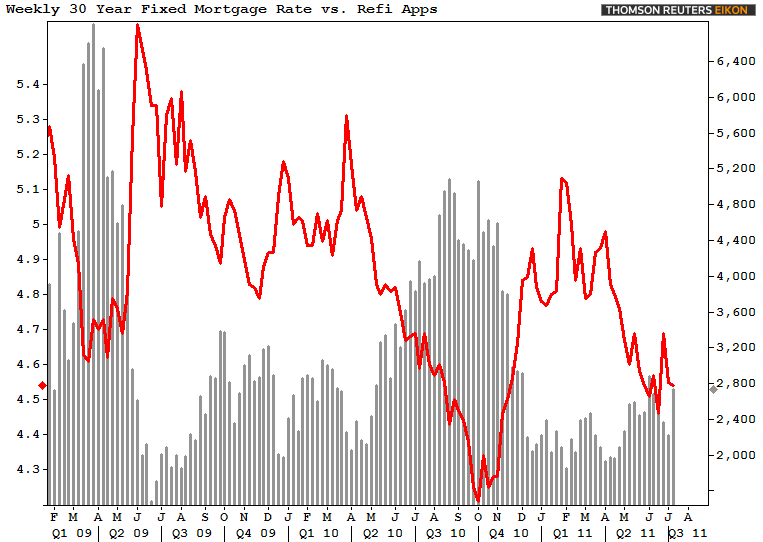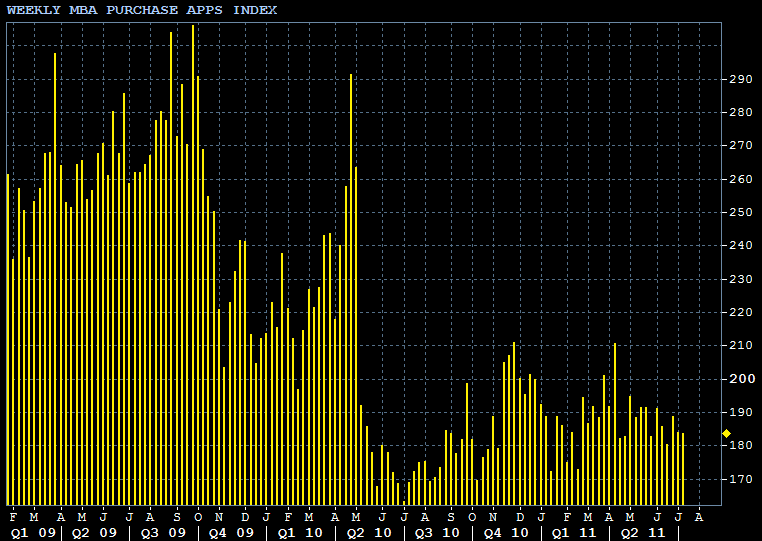The Mortgage Bankers Association today reported a significant increase in the number of refinance applications taken last week, purchase demand on the other hand declined slightly.
The Market Composite Index, which takes both purchases and refinances into account, rose by 15.5% to 556.0, it's fastest pace since the week of March 4th, 2011. The gain would have been less of an outlier had it not been for last week being the lowest index level since April.
The current report draws all its strength from refinance applications. MBA's refinance index rose a whopping 23.1 pct, its largest jump since January 2010 (the fastest week over week change in 2011 was seen in February at just under 18%). When looking closer at refinance activity, its 4-week moving average creates a more moderate picture. The previous four reports all showed decreasing demand. The uptick in activity reported today ended that losing streak.

The connection between this surge in refinance demand and the average reported interest rate is tenuous as rates only moved down from 4.55 pct to 4.54 pct on average. Today's report brings the 4 week moving average of reported contract interest rates from 4.5675 pct only marginally lower to 4.56 pct.
The chart below illustrates how the presence of lower rates has not brought with it extra refinance demand, not to the extent it has in the past. Generally more stringent underwriting guidelines combined with generally decreasing home values and the fact that markets have had several opportunities at similar rates over the past few years suggest exhaustion in the refi market as the culprit.

The purchase index fell 0.1 pct to 183.7, effectively unchanged from last week's reading of 183.9. Although this is up from the 160-170's levels during this time last year, those were the lowest index levels on record.
In the chart below, note that the index is historically quite low, and still stagnant. Also of note is that with few exceptions, an index value of 200 is the dividing line between the current stagnation, representing the best levels since May 2010 and the worst levels from any time prior. That then, seems like the inflection point needing to be decisively moved through before we could consider purchase demand to have turned any sort of corner.

----
* ABOUT: The MBA's loan application survey covers over 50% of all U.S. residential mortgage loan applications taken by mortgage bankers, commercial banks, and thrifts. The data gives economists a snapshot view of consumer demand for mortgage loans. In a falling mortgage rate environment, a trend of increasing refinance applications implies consumers are seeking out lower monthly payments. If consumers are able to reduce their monthly mortgage payment and increase disposable income through refinancing, it can be a positive for the economy as a whole (may boost consumer spending. It also allows debtors to pay down personal liabilities faster. A trend of declining purchase applications implies home buyer demand is shrinking.







